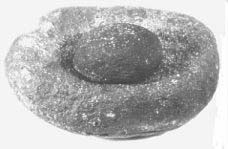 |
 |
| Basket of neolithic period made from slivers of wood bound with grass. Found at Twyford, Co. Westmeath National Museum of Ireland |
A simple quern for grinding grain. National Museum of Ireland |
The transition from foraging to farming took place in Ireland about 4200 BC. How it happened is unclear. Did gathering and hunting people learn to farm or did farmers arrive and intermarry with them or even displace them? One way or another, cattle, sheep, wheat and barley had to be brought in by boat as they were not native to Ireland. Horses seem to have arrived in the later Neolithic period. Farming progressed gradually and has shaped the landscape and people of Ireland for about six thousand years now.
Farming is a more reliable method of providing food for an increasing population than gathering and hunting but requires much more work. The earliest farmers felled trees with polished stone axes to make clearances for their farms. People eventually settled in one place for long periods of time and doubtless developed an attachment to places, burying their dead in impressive and lasting monuments. Cattle, sheep and goats were tended, protected, slaughtered and butchered. The majority of the Neolithic animal bones which have been excavated so far are those of cattle slaughtered when they were young, suggesting that they were used more for meat than dairying.
Wooden and bone implements were used for fencing in crops, tilling, hoeing and harvesting. Bags, buckets and other containers were made from available materials. Pottery was made from clay and decorated. Life could be tough.
The basket pictured below, found in a bog in Westmeath, was made from long slivers of wood bound with straw. The quern was used for grinding grain which was made into breads and porridges.
 |
 |
| Basket of neolithic period made from slivers of wood bound with grass. Found at Twyford, Co. Westmeath National Museum of Ireland |
A simple quern for grinding grain. National Museum of Ireland |
| Anne Lynch excavated the Poulnabrone portal tomb on the Burren in Co. Clare and uncovered a well-preserved burial deposit and especially valuable evidence for the landscape history of the region in neolithic times between about 3800-3200 BC. In the chamber were preserved the disarticulated unburned remains of up to thirty-three individuals - of these seventeen were adults and sixteen were children. Life expectancy was poor by modern standards - the majority of the adults had died by the age of about thirty - and the wear and tear on the vertebrae suggested that they had experienced a lifetime of hard physical labour, while their teeth indicated that they had survived on a diet of coarse, occasionally abrasive food. The tip of a chert or flint arrowhead was embedded in the ilium of what was probably a male. Frank Mitchell and Michael Ryan, Reading the Irish landscape, Dublin, 1998, p. 169. |
Some farm jobs could be shared by women, men and children while others, especially in the past, required considerable physical strength and could involve danger to pregnant women and children. It is possible that a gender division of labour developed and that many women now combined child-minding with time-consuming and often monotonous jobs near the home. Whether such a development in lifestyle occurred and affected the status of women at that time is quite unclear.
| Attention has turned especially to the implications of the sexual division of labour. All human societies specify certain tasks as appropriate for one sex or the other. The division is not totally arbitrary. In all known human societies, females have primary responsibility for early child care; males have primary responsibility for big-game hunting. But the division of labour alone does not automatically mean that the labour of one sex is more highly valued than that of the other. The division of labour leads to female subordination only when societies are subjected to specific kinds of social stress. Bonnie S. Anderson & J.P. Zinsser, A history of their own, Penguin Books, 1988, p 13. |
|
Archaeology may reveal the relative prestige of women and men indirectly.
Archaeologists have not been able to reach firm conclusions based on such evidence for Neolithic Ireland so far. They have found fewer remains of children and adolescents than their proportion of the population and expected high child mortality would lead them to expect. One type of Neolithic burial which has been radio-carbon dated to about 3500 BC seems to indicate higher male prestige for at least one group. |
 |
| Beads, pendants, buttons made from bone, antler, stone. Found in passage graves. Perhaps attached to the clothes of the dead. National Museum of Ireland |
| Linkardstown cists seem to have had a preponderance of male burials ... they show a clear interest on the part of their builders in the interment of a very restricted category of individuals, probably people of high status, normally males. Frank Mitchell and Michael Ryan, Reading the Irish Landscape, Dublin, 1998, p. 178. |
There were, of course, regional variations and many changes over a period greater than two thousand years. Material remains of Neolithic peoples may be visited and they include field patterns under the bogs at the Céide Fields in County Mayo, remains of homesteads at Lough Gur and megalithic tombs of several types, of which the most famous is the passage tomb at Newgrange in the Boyne Valley.